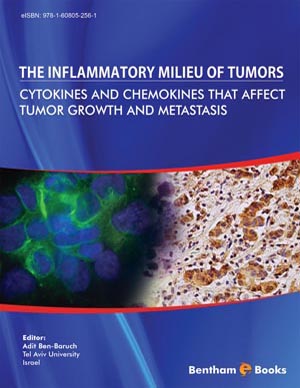Abstract
Cancer diseases are driven by intrinsic properties of cells that have undergone malignant transformation, aided by a supporting microenvironment. Often, the tumor milieu contains inflammatory cells and soluble inflammatory factors whose activities facilitate the growth of the tumor at the primary site, and also metastasis formation. This chapter will describe the roles of inflammatory members of the CC family of chemokines in cancer, focusing on CCL2 (MCP-1) and CCL5 (RANTES). In line with their activities in the immune setting, there are cases in which the two chemokines induce the recruitment of leukocytes with anti-tumor activities to tumors. However, this potential activity of CCL2 and CCL5 is overcome in the majority of malignant diseases by their very potent tumor-promoting functions. By using breast cancer as the test case, this chapter will describe the large variety of manners and mechanisms by which CCL2 and CCL5 promote malignancy, including: (1) The ability of both chemokines to change the type of leukocyte infiltrates in tumors so that the equilibrium is shifted towards the presence of cells that promote malignancy, such as tumor-associated macrophages (TAM) and Th17 cells. These functions of CCL2 and CCL5 take place in parallel to reduced anti-tumor T cell activities. (2) The angiogenic activities of CCL2 and its ability to “condition” the bone microenvironment towards “seeding” by the tumor cells. (3) The roles of CCL2 in promoting the presence of mesenchymal stem cells (MSC) in tumors, and the ability of CCL5 to mediate the promalignancy activities of these cells. (4) The direct activity of CCL5 (and to some extent also of CCL2) on the tumor cells, leading to their increased motility and invasion, and the stimulation of matrix metalloproteinase (MMP) production by the chemokine. These activities of the chemokines can together enhance metastatic dissemination. Therefore, the currently available information suggests that CCL2 and CCL5 should be considered as potential therapeutic targets and as diagnostic/prognostic tools in breast cancer and possibly in other malignant diseases.
Keywords: Breast cancer, inflammation, CCL2 (MCP-1), CCL5(RANTES).






















